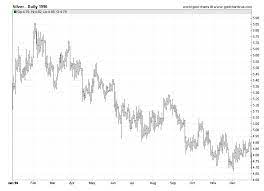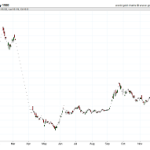The year 1996 saw significant fluctuations in the price of silver, with values ranging from $4.73 to $5.26 per ounce. This period of volatility in the silver market was influenced by a variety of factors, both domestic and international. This article aims to provide an in-depth analysis of the silver price history in 1996, including daily price data and the factors that shaped the market.
By examining the daily prices of silver from July 15 to December 31, 1996, we can gain insights into the trends and patterns that characterized this period. Despite the fluctuations, the silver market remained active, with a range of factors contributing to the changing prices.
This article will explore the various factors that influenced these fluctuations, including changes in supply and demand, geopolitical events, and macroeconomic factors such as inflation and interest rates. By examining these factors in detail, we can gain a deeper understanding of the complex dynamics that drove the silver market in 1996 and the implications these fluctuations had for investors and traders.
Historical Silver Prices
The historical silver price data available indicates that silver prices in 1996 fluctuated between $4.73 oz and $5.26 oz from July 15 to December 31. During this period, silver prices experienced various price trends that reflect the market analysis of the time.
For instance, prices on July 15 and 16 were $5.14 oz and $5.15 oz, respectively, indicating a stable market. In contrast, prices on November 4 and 5 were $4.81 oz and $4.83 oz, respectively, suggesting a bearish trend in the market.
These price fluctuations were influenced by various factors such as market demand, global economic conditions, and political stability. For instance, in the second half of 1996, there was a decline in global economic growth, which affected silver prices.
Additionally, the market demand for silver also contributed to the price trends, as the greater the demand in the market, the higher the prices. Therefore, understanding the historical silver price trends is crucial for investors seeking to allocate their assets in the precious metals market.
Daily Price Data
From July to December of 1996, the daily data for the pricing of silver displayed significant variability. The prices fluctuated between $4.73 oz and $5.26 oz, with daily changes spanning anywhere from $0.01 to $0.08 oz. These trading patterns could be attributed to various factors, such as changes in supply and demand, fluctuations in the US dollar, and global events impacting the precious metals market.
Investors during this time may have experienced a sense of uncertainty and anxiety as they closely monitored the daily price movements of silver. The volatility of the market could have evoked emotions such as fear, anxiety, and greed, as traders attempted to capitalize on potential profits.
The impact of global events, such as political instability or economic crises, could have added further complexity to the daily price fluctuations, making it difficult to predict market movements. Despite the unpredictability of the market, investors continued to trade in the silver market, hoping to achieve financial gain through careful analysis and strategic investment decisions.
Factors Influencing Price Fluctuations
Factors influencing the variability of silver pricing during the period of July to December 1996 include changes in market demand, fluctuations in the US dollar, and geopolitical events impacting the precious metals market.
Market demand for silver is a major factor in determining its price. As demand increases, the price of silver also increases, and vice versa. During the period under consideration, variations in market demand were influenced by factors such as the growth of the electronics industry, the strength of the global economy, and the changing preferences of investors.
Fluctuations in the US dollar also played a significant role in determining the price of silver. As one of the world’s leading currencies, changes in the value of the US dollar can affect the price of silver and other precious metals. For example, when the value of the dollar declines, silver prices usually rise. On the other hand, when the value of the dollar increases, silver prices often fall.
Finally, geopolitical events such as wars, political instability, and natural disasters can have a significant impact on the price of silver. These events can cause significant disruptions in the global supply chain, which can lead to significant changes in the price of silver and other precious metals.
Frequently Asked Questions
What were the major events that affected silver prices in 1996?
The silver market trends in 1996 were influenced by a range of factors including the strength of the US dollar, economic growth, and supply and demand dynamics. Precious metal investments were impacted by geopolitical events and monetary policy decisions, which created volatility in the market.
What is the current demand for silver and how does it compare to 1996?
Current silver demand remains strong, driven by industrial and investment demand. Market trends suggest a continued increase in demand, with prices reaching new highs in recent years. However, demand and prices in 1996 were influenced by different economic and geopolitical factors.
What are the most common uses of silver and how do they impact its price?
Silver is widely used in industrial applications, accounting for approximately 60% of its demand. Its conductivity, malleability, and antibacterial properties make it valuable in electronics, solar panels, and medical equipment, influencing its price.
How do geopolitical events and economic factors affect the price of silver?
Geopolitical tensions and commodity market fluctuations can affect the price of silver. Investors often seek safe-haven assets like silver during times of uncertainty, driving up demand and prices. Economic factors such as inflation and interest rates also impact silver prices.
What is the outlook for silver prices in the future and how can investors best position themselves?
Investment strategies for silver prices in the future are largely dependent on industry trends. Analyzing market factors such as production levels, geopolitical events, and currency fluctuations can assist investors in making informed decisions about their portfolios.





